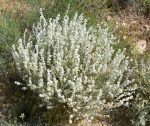 Winterfat is a long-lived evergreen small shrub and member of the amaranth family, Amaranthaceae, that also includes celosia, spinach and beet. It is native to western North America from Saskatchewan to Washington, south to Texas and California into Mexico where it grows in dry plains, xeric scrublands, dry valley bottoms, mesas and in salty soils such as those of the alkali flats in the Great Basin, Central Valley, Great Plains, and Mojave Desert. Plants grow up to 4′ tall from a long taproot with lateral branches and have flexible stems covered with dense white hairs and carrying small, woolly blue-green linear leaves that become reddish with age. From early spring to summer, dense terminal and axillary spikes of inconspicuous apetalous male and female flowers appear. The male flowers have large woolly leaf like bracts while the female flowers have small bracts and produce tiny white seeds with silky white hairs during the fall. Winterfat is an attractive ornamental for the xeric landscape and serves as forage for grazing cattle and wildlife. It also can be used for erosion control and revegetation. The genus name, Krascheninnikovia, honors Stepan Krasheninnikov, an early 18th century Russian botanist and explorer of Siberia and Kamchatka. The specific epithet, lanata, is the Latin word meaning woolly and refers to the covering of hairs on the stems and leaves.
Winterfat is a long-lived evergreen small shrub and member of the amaranth family, Amaranthaceae, that also includes celosia, spinach and beet. It is native to western North America from Saskatchewan to Washington, south to Texas and California into Mexico where it grows in dry plains, xeric scrublands, dry valley bottoms, mesas and in salty soils such as those of the alkali flats in the Great Basin, Central Valley, Great Plains, and Mojave Desert. Plants grow up to 4′ tall from a long taproot with lateral branches and have flexible stems covered with dense white hairs and carrying small, woolly blue-green linear leaves that become reddish with age. From early spring to summer, dense terminal and axillary spikes of inconspicuous apetalous male and female flowers appear. The male flowers have large woolly leaf like bracts while the female flowers have small bracts and produce tiny white seeds with silky white hairs during the fall. Winterfat is an attractive ornamental for the xeric landscape and serves as forage for grazing cattle and wildlife. It also can be used for erosion control and revegetation. The genus name, Krascheninnikovia, honors Stepan Krasheninnikov, an early 18th century Russian botanist and explorer of Siberia and Kamchatka. The specific epithet, lanata, is the Latin word meaning woolly and refers to the covering of hairs on the stems and leaves.
Outstanding Feature: White woolly appearance
Form: Vase-shaped
Growth Rate:Moderate
Bloom: Dense spikes of male and female apetalous flowers from early spring until summer
Size: 1-4′ h x 2’4′ W
Light: Full sun
Soil: Average, dry, well-drained; tolerates salty soil
Hardiness: Zones 6-9
Care:Cut back in early spring to keep bushy
Pests and Diseases: None of significance
Propagation: Seed or softwood cuttings;stratification enhances germination rate.
Photo Credit: Wikipedia